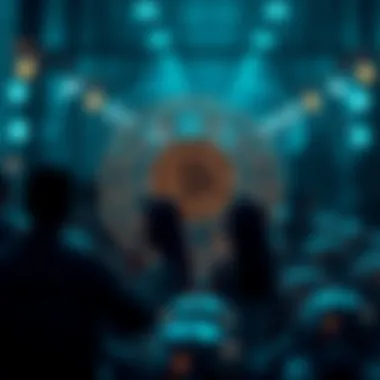Exploring Decentralized Autonomous Organizations and Their Impact


Intro
Decentralized Autonomous Organizations (DAOs) have emerged as a revolutionary concept within the blockchain ecosystem. A DAO operates without a central authority, utilizing smart contracts to enable members to govern without traditional hierarchical structures. The fundamental idea is straightforward: in a DAO, decisions are made collectively, and governance is driven by code rather than individuals. This paradigm shift poses interesting questions about the nature of collaboration, participation, and control in organizations.
As we journey into the realm of DAOs, it's crucial to unravel the foundational elements that make them work. By understanding the blockchain backbone that supports these organizations, we can better appreciate their nuances and implications. The movement toward decentralized governance parallels broader trends in technology and society, challenging conventional norms and prompting reflection on accountability and transparency.
We’ll explore a variety of notable examples, examining how different DAOs tackle unique challenges and opportunities while determining their effectiveness and potential pitfalls. The discourse reveals a landscape filled with contrasting philosophies and strategies.
Cryptocurrency Basics
Understanding Blockchain Technology
At the very core of DAOs lies blockchain technology, an innovative system that records transactions in a secure, tamper-proof manner. Each block in the chain is cryptographically linked to the previous one, creating an unalterable record. This infrastructure enables trust without reliance on third parties. A broad understanding of blockchain helps clarify how DAOs operate. With decentralized networks, there’s no single point of failure, significantly reducing the risk of corruption or fraud.
One noteworthy example is the Ethereum platform, which has become the primary choice for many DAOs due to its flexibility in deploying smart contracts. Smart contracts, which are self-executing contracts with the terms directly written into code, play a pivotal role in automating decision-making and funding processes within DAOs.
Key Terminology Explained
To navigate through DAOs successfully, familiarity with key terms is necessary.
- Smart Contracts: Automated contracts that self-execute when conditions are met.
- Tokens: Digital assets that often represent governance rights within a DAO. Members use tokens to vote on proposals.
- Voting Mechanisms: Various ways DAOs allow members to vote, such as one-token-one-vote or quadratic voting.
- Treasury Management: How DAOs manage their funds, often decentralized and reliant on community consensus.


Understanding these concepts forms a solid foundation in appreciating the complexities of how DAOs function and the various ways they can encapsulate decision-making and distribute power among their members.
"DAOs represent a gamble on the resilience of community and collaboration—an experiment in governance untethered from traditional boundaries."
As we ponder over these foundational aspects, the next section will delve into real-world applications and implications of DAOs, showcasing how they're reshaping governance and collaboration in unprecedented ways.
Understanding Decentralized Autonomous Organizations
Decentralized Autonomous Organizations, or DAOs, represent a seismic shift in the way we think about governance and organization. Their unique structure allows for increased participation without central authority. This is significant in today’s digital landscape where traditional power hierarchies are increasingly scrutinized. By exploring DAOs, we can uncover not only their functionalities but also the broader implications for governance, collaboration, and trust in digital interactions.
Definition of DAOs
At its core, a Decentralized Autonomous Organization is an entity that operates without centralized control while remaining autonomous via self-executing agreements embedded in blockchain technology. The most defining feature is that these organizations are governed by code instead of human intervention. This shifts the paradigm from traditional organizational frameworks to ones that are democratic and transparent.
Historical Context
DAOs have roots deep in the early blockchain community, inspired by the spirit of decentralization that the technology promotes. The conception of DAOs can be traced back to initiatives like Bitcoin, which introduced decentralized currency. However, the formalization of DAOs began with The DAO, launched in 2016 as a venture capital fund, dramatically demonstrating both the potential and pitfalls of such entities. The explosion of interest in DAOs represents a fundamentally different approach to governance, breaking boundaries and allowing a broader spectrum of participation.
Core Principles of DAOs
The essence of DAOs lies in several core principles that collectively shape their effectiveness and appeal in the current digital era.


Decentralization
Decentralization is the backbone of DAOs. It eliminates single points of failure and fosters a more resilient structure, reducing the risk of power concentration. This characteristic allows decisions to be made collectively, which not only empowers participants but also creates a level of trust that individual leadership cannot guarantee. The unique feature here is that decision-making is not funneled through a central authority, but rather distributed among members, fostering accountability.
Transparency
Transparency is another pillar supporting the DAO framework. All transactions and rules are recorded on the blockchain, visible and immutable to all participants. This level of openness ensures that actions taken by the organization can be audited and assessed by anyone at any time. Such transparency minimizes corruption and misunderstandings, strengthening the community's trust in the organization. However, despite its strengths, deciphering data from blockchains can still be challenging for those not familiar with tech jargon.
Programmability
The programmability aspect of DAOs involves creating rules and protocols that govern interactions within the organization through smart contracts. This feature allows for flexibility and adaptability; organizations can pivot their strategies and modify governance based on changing conditions without requiring a complete overhaul. But on the flip side, if these contracts contain flaws, the impact can be significant, leading to unintended consequences and vulnerabilities in the DAO's operations.
"The innovation of DAOs lies not just in the absence of leadership but in the potential for everyone to contribute to the conversation in real-time—redrawing the map of participation."
In summary, understanding DAOs entails recognizing their decentralized nature, the importance of transparency, and how programmability facilitates innovative solutions. This foundation is crucial as we navigate the complexities surrounding DAOs and their potential to redefine organizational structures in the digital age.
Key Characteristics of DAOs
Decentralized Autonomous Organizations, or DAOs, embody revolutionary concepts that alter the landscape of governance within the crypto ecosystem. Understanding the core characteristics of DAOs is crucial for anyone looking to grasp their implications and potential. DAOs leverage technology to foster levels of participation, transparency, and efficiency rarely seen in traditional organizations. By examining these key traits—self-governance, token-based voting, and smart contracts—we can appreciate how they function and their relevance for various stakeholders.
Self-Governance


Self-governance stands as one of the most significant features of DAOs. This principle allows members to take an active role in decision-making processes, fostering a sense of ownership and accountability. Unlike conventional entities, where a handful of individuals or a board often dictate the direction, a DAO empowers all token holders to voice their opinions.
This participatory model breeds engagement, encouraging members to contribute their expertise and perspectives. Furthermore, self-governance can minimize bureaucratic delays—it facilitates faster decisions compared to traditional hierarchies. However, it's not without challenges. Reaching a consensus among large groups can be cumbersome and time-consuming. In essence, while self-governance enhances involvement, it also requires mechanisms to handle diverse opinions effectively.
Token-Based Voting Mechanisms
Token-based voting is integral to the operational fabric of DAOs. Through this approach, voting power is often proportional to the number of tokens a member holds. This method creates a direct link between the influence a member has and their investment in the organization’s wellbeing.
The upside of this system includes an incentivized stakeholder participation. Investors are more likely to engage in governance to protect their investments. However, it can lead to concerns regarding equity—higher token holdings could concentrate power among a select few, raising questions about fairness in representation.
Some noteworthy considerations while discussing token-based voting include:
- Inclusivity: Ensuring all voices are heard, particularly from those with fewer tokens.
- Security: Safeguarding against vote manipulation through hacking or other malicious activities.
- Adaptability: Being careful to adjust voting mechanisms to reflect the changing nature of governance needs.
Smart Contracts in DAOs
Smart contracts are pivotal to the functionality of DAOs, acting as self-executing agreements coded onto the blockchain. They allow for automated, trustless transactions based on pre-defined conditions without the need for intermediary involvement.
Role of Smart Contracts
The role of smart contracts in DAOs cannot be overstated; they are the backbone that maintains the operational integrity of the organization. By defining rules and conditions for proposals, they facilitate transparent and objective decision-making. One remarkable characteristic of smart contracts is their immutability: once deployed, they cannot be tampered with, enhancing security and trust among members.
This attribute makes smart contracts a popular choice for DAOs. However, while they offer significant advantages, the initial design and coding process necessitates precision—any overlooked detail can lead to vulnerabilities.
plaintext Examples of potential issues
- Code Bugs: Minor errors can lead to major exploits.
- Lack of Flexibility: Changes may require full redeployment.



